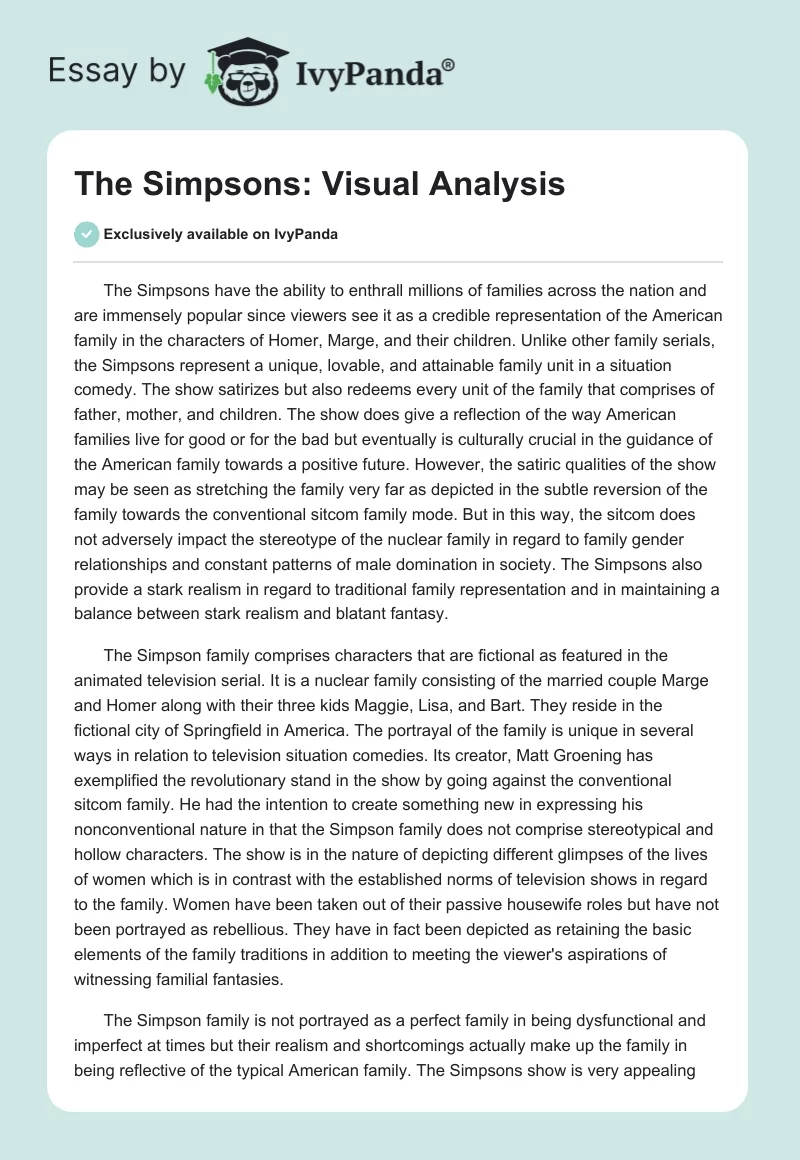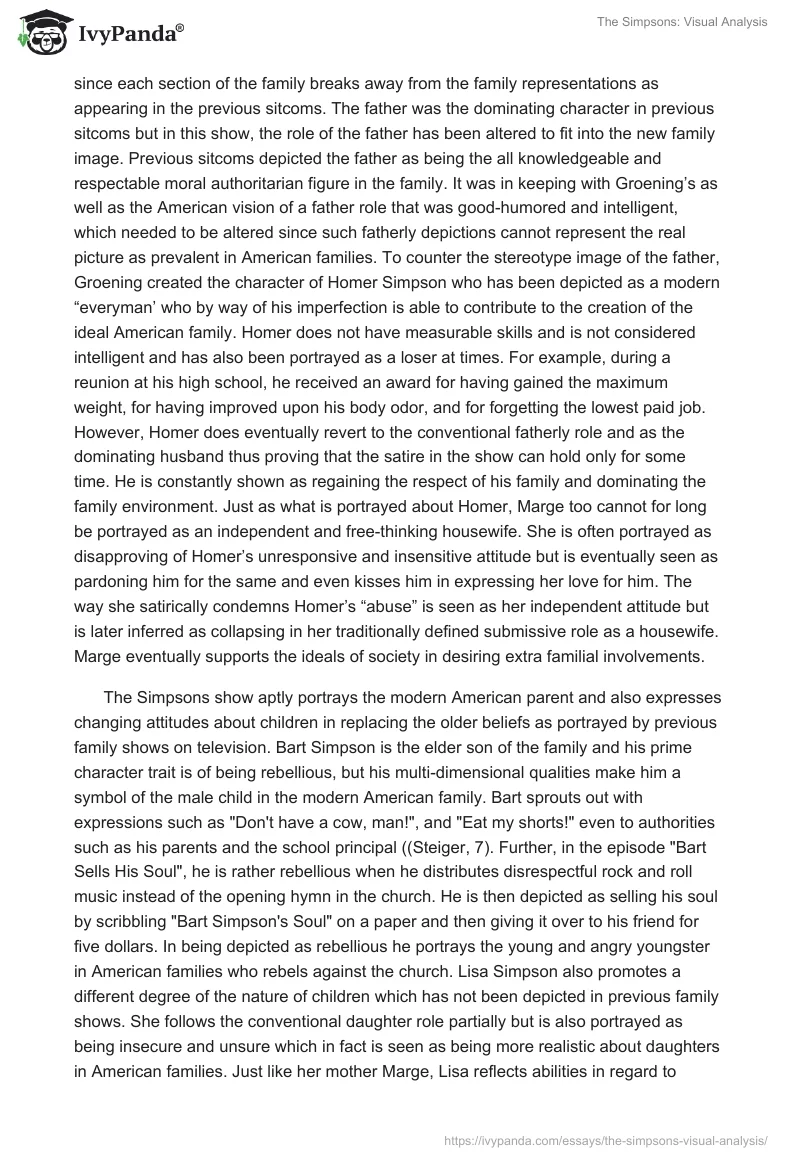The Simpsons have the ability to enthrall millions of families across the nation and are immensely popular since viewers see it as a credible representation of the American family in the characters of Homer, Marge, and their children. Unlike other family serials, the Simpsons represent a unique, lovable, and attainable family unit in a situation comedy. The show satirizes but also redeems every unit of the family that comprises of father, mother, and children. The show does give a reflection of the way American families live for good or for the bad but eventually is culturally crucial in the guidance of the American family towards a positive future. However, the satiric qualities of the show may be seen as stretching the family very far as depicted in the subtle reversion of the family towards the conventional sitcom family mode. But in this way, the sitcom does not adversely impact the stereotype of the nuclear family in regard to family gender relationships and constant patterns of male domination in society. The Simpsons also provide a stark realism in regard to traditional family representation and in maintaining a balance between stark realism and blatant fantasy.
The Simpson family comprises characters that are fictional as featured in the animated television serial. It is a nuclear family consisting of the married couple Marge and Homer along with their three kids Maggie, Lisa, and Bart. They reside in the fictional city of Springfield in America. The portrayal of the family is unique in several ways in relation to television situation comedies. Its creator, Matt Groening has exemplified the revolutionary stand in the show by going against the conventional sitcom family. He had the intention to create something new in expressing his nonconventional nature in that the Simpson family does not comprise stereotypical and hollow characters. The show is in the nature of depicting different glimpses of the lives of women which is in contrast with the established norms of television shows in regard to the family. Women have been taken out of their passive housewife roles but have not been portrayed as rebellious. They have in fact been depicted as retaining the basic elements of the family traditions in addition to meeting the viewer’s aspirations of witnessing familial fantasies.
The Simpson family is not portrayed as a perfect family in being dysfunctional and imperfect at times but their realism and shortcomings actually make up the family in being reflective of the typical American family. The Simpsons show is very appealing since each section of the family breaks away from the family representations as appearing in the previous sitcoms. The father was the dominating character in previous sitcoms but in this show, the role of the father has been altered to fit into the new family image. Previous sitcoms depicted the father as being the all knowledgeable and respectable moral authoritarian figure in the family. It was in keeping with Groening’s as well as the American vision of a father role that was good-humored and intelligent, which needed to be altered since such fatherly depictions cannot represent the real picture as prevalent in American families. To counter the stereotype image of the father, Groening created the character of Homer Simpson who has been depicted as a modern “everyman’ who by way of his imperfection is able to contribute to the creation of the ideal American family. Homer does not have measurable skills and is not considered intelligent and has also been portrayed as a loser at times. For example, during a reunion at his high school, he received an award for having gained the maximum weight, for having improved upon his body odor, and for forgetting the lowest paid job. However, Homer does eventually revert to the conventional fatherly role and as the dominating husband thus proving that the satire in the show can hold only for some time. He is constantly shown as regaining the respect of his family and dominating the family environment. Just as what is portrayed about Homer, Marge too cannot for long be portrayed as an independent and free-thinking housewife. She is often portrayed as disapproving of Homer’s unresponsive and insensitive attitude but is eventually seen as pardoning him for the same and even kisses him in expressing her love for him. The way she satirically condemns Homer’s “abuse” is seen as her independent attitude but is later inferred as collapsing in her traditionally defined submissive role as a housewife. Marge eventually supports the ideals of society in desiring extra familial involvements.
The Simpsons show aptly portrays the modern American parent and also expresses changing attitudes about children in replacing the older beliefs as portrayed by previous family shows on television. Bart Simpson is the elder son of the family and his prime character trait is of being rebellious, but his multi-dimensional qualities make him a symbol of the male child in the modern American family. Bart sprouts out with expressions such as “Don’t have a cow, man!”, and “Eat my shorts!” even to authorities such as his parents and the school principal ((Steiger, 7). Further, in the episode “Bart Sells His Soul”, he is rather rebellious when he distributes disrespectful rock and roll music instead of the opening hymn in the church. He is then depicted as selling his soul by scribbling “Bart Simpson’s Soul” on a paper and then giving it over to his friend for five dollars. In being depicted as rebellious he portrays the young and angry youngster in American families who rebels against the church. Lisa Simpson also promotes a different degree of the nature of children which has not been depicted in previous family shows. She follows the conventional daughter role partially but is also portrayed as being insecure and unsure which in fact is seen as being more realistic about daughters in American families. Just like her mother Marge, Lisa reflects abilities in regard to female domesticating qualities that she just cannot get away with. She demonstrates her brotherly love when she buys back Bart’s soul and assists him out of the crises thus demonstrating her caring attitude for the family.
If examined separately, all the characters, Homer, Marge, Bart, and Lisa display qualities that were so far not seen in family units of other shows, thus promulgating fresh and achievable models for people in leading their lives. Upon studying the Simpsons as a family unit, the characters are seen as pulling the traits of each other into a rational sum total which can be appreciated and believed by families throughout the country. James L Brooks has truly said of the Simpson family as representing “the normal American family in all its beauty and horror,” (Kaufman, 108). The Simpsons could be having atrocious personal qualities such as Homer’s silliness and Bart’s rebellious nature, but such imperfections make them delightful since no family can function in an ideal manner. As stated by Richard Corliss, “they stick with one another through thick and thin,” and “they have a heart that reveals [s] the bedrock fondness, desperation, and loyalty that bond this or any other frazzled clan,” (Corliss, 77). The cohesiveness of the family is demonstrated when Marge is truthful to Homer regardless of his stupidity in “A Streetcar Named Marge.” Lisa’s love for Bart as depicted in “Bart Sells His Soul,” exemplifies the defining traits of an ideal and stable family. The family members continuously love each other and do not display any element of anger for the other. The show presents a more balanced viewpoint of what a family should be like while at the same time retaining some ideal visions about what a nuclear family is supposed to strive for.
The show aptly demonstrates the balancing act between rebellion and idealism in portraying the nature of the American nuclear family. Corliss (1994) has stated in regard to the Simpsons family that it is their “fondness, desperation, and loyalty that also bonds any other family, which explains why so many families, including my own, are so drawn to the show. After all, many studies have underlined the overall unreality of the television family and viewer dissatisfaction with such representations” (Stewart, 1983). People can relate to characters in the show and can identify their own lifestyles with what happens with the Simpson family members. Simpsons are certainly not a perfect family nor do they make claims in this regard. Every character is seen as having some imperfection while the family is not perfect from all perspectives which makes the Simpsons a perfect model of the television family which everybody can appreciate, love, and follow in experiencing the happiness and realities of life as portrayed in the show. Similarly in waning towards the tradition of family sitcoms, the Simpson’s depict how television shows cannot deviate from established family images such as family satire which can only be carried forward to a certain limit. Ultimately the voice of tradition and convention takes over in retaining the family qualities that have not been discarded by society. But the Simpson’s continue to be the cracked mirror version of each family’s lovable but imperfect characteristics.
References
Corliss, Richard. ” ‘Simpsons’ forever!” Time 1994.
Eliezer Van Allen, An Imperfect Ideal Family, 2009. Web.
Kaufman, Joanne. “Life in Hell’s Matt Groening goes overboard to make The Simpsons the first family of TV ‘toons.” People Weekly 1989.
Steiger, Gerd. “The Simpsons – Just Funny or More?” 1999. Online Posting. The Simpsons Archive. Web.
Stewart, Donald E. The Television Family. Melbourne: Institute of Family Studies, 1983.


